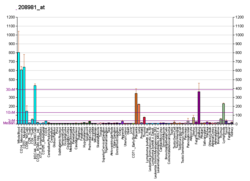PECAM1
Le PECAM1 (pour « Platelet endothelial cell adhesion molecule ») ou CD31 est une protéine de type cluster de différenciation dont le gène est PECAM1 situé sur le chromosome 17 humain.
Rôles modifier
Son poids moléculaire est de 130 kDa[5]. Il s'agit d'une protéine transmembranaire avec une partie extracellulaire composée de six domaines de type immunoglobuline, une partie transmembranaire et une partie cytoplasmique[6], cette dernière comportant un domaine de type inhibiteur de tyrosine kinase[7]. Il est exprimé à la surface des cellules endothéliales, des cellules hématopoïétiques, des lymphocytes et des cellules dendritiques[7]. Il joue un rôle dans la régulation de l'inflammation[8]. Dans la plaque d'athérome, il inhibe la formation d'une thrombose[9].
Exprimé dans les jonctions intercellulaires, il est lié à la vimentine[10]. Il agit comme un capteur de cisaillement au niveau de la paroi des artérioles : en cas de déformation de cette dernière[11], la protéine est phosphorylée[12] et active le système Akt et la NO synthase[13] permettant la production du monoxyde d'azote (NO) entraînant une vasodilatation.
Il pourrait jouer un rôle dans la genèse de l'athérome[14] mais cette action est variable suivant le site artériel concerné[15]. Il pourrait intervenir dans la genèse d'un anévrisme de l'aorte abdominale[16]. Dans l'angine de poitrine, son expression est augmentée, et diminuée transitoirement en cas de syndrome coronarien aigu[17].
Le MMP9 dégrade la partie extracellulaire du CD31[18] en coupant les cinq premiers domaines de type immunoglobuline[19], inhibant l’activité de la protéine.
Notes et références modifier
- GRCh38: Ensembl release 89: ENSG00000261371 - Ensembl, May 2017
- GRCm38: Ensembl release 89: ENSMUSG00000020717 - Ensembl, May 2017
- « Publications PubMed pour l'Homme », sur National Center for Biotechnology Information, U.S. National Library of Medicine
- « Publications PubMed pour la Souris », sur National Center for Biotechnology Information, U.S. National Library of Medicine
- Newman PJ, Switched at birth: a new family for PECAM-1, J Clin Invest, 1999;103:5–9
- Newman PJ, Newman DK, Signal transduction pathways mediated by PECAM-1: new roles for an old molecule in platelet and vascular cell biology, Arterioscler Thromb Vasc Biol, 2003;23:953–964
- Marelli-Berg FM, Clement M, Mauro C, Caligiuri G, An immunologist's guide to CD31 function in T-cells, J Cell Sci, 2013;126:2343–2352
- Privratsky JR, Newman DK, Newman PJ, PECAM-1: conflicts of interest in inflammation, Life Sci, 2010;87:69–82
- Caligiuri G, Groyer E, Khallou-Laschet J et al. Reduced immunoregulatory CD31+ T cells in the blood of atherosclerotic mice with plaque thrombosis, Arterioscler Thromb Vasc Biol, 2005;25:1659–1664
- Conway DE, Breckenridge MT, Hinde E, Gratton E, Chen CS, Schwartz MA, Fluid shear stress on endothelial cells modulates mechanical tension across VE-cadherin and PECAM-1, Curr Biol, 2013;23:1024–1030
- Bagi Z, Frangos JA, Yeh JC, White CR, Kaley G, Koller A, PECAM-1 mediates NO-dependent dilation of arterioles to high temporal gradients of shear stress, Arterioscler Thromb Vasc Biol, 2005;25:1590–1595
- Wang S, Iring A, Strilic B et al. P2Y2 and Gq/G11 control blood pressure by mediating endothelial mechanotransduction, J Clin Invest, 2015;125:3077-3086
- Fleming I, Fisslthaler B, Dixit M, Busse R, Role of PECAM-1 in the shear-stress-induced activation of Akt and the endothelial nitric oxide synthase (eNOS) in endothelial cells, J Cell Sci, 2005;118(pt 18):4103–4111
- Harry BL, Sanders JM, Feaver RE et al. Endothelial cell PECAM-1 promotes atherosclerotic lesions in areas of disturbed flow in ApoE-deficient mice, Arterioscler Thromb Vasc Biol, 2008;28:2003–2008
- Goel R, Schrank BR, Arora S et al. Site-specific effects of PECAM-1 on atherosclerosis in LDL receptor-deficient mice, Arterioscler Thromb Vasc Biol, 2008;28:1996–2002
- Caligiuri G, Rossignol P, Julia P et al. Reduced immunoregulatory CD31+ T cells in patients with atherosclerotic abdominal aortic aneurysm, Arterioscler Thromb Vasc Biol, 2006;26:618–623
- Flego D, Severino A, Trotta F et al. Altered CD31 expression and activity in helper T cells of acute coronary syndrome patients, Basic Res Cardiol, 2014;109:448
- Kato H, Kuriyama N, Duarte S, Clavien PA, Busuttil RW, Coito AJ, Mmp-9 deficiency shelters endothelial pecam-1 expression and enhances regeneration of steatotic livers after ischemia and reperfusion injury, J Hepatol, 2014;60:1032–1039
- Angelini G, Flego D, Vinci R et al. Matrix metalloproteinase-9 might affect adaptive immunity in non-ST segment elevation acute coronary syndromes by increasing CD31 cleavage on CD4+ T-cell, Eur Heart J, 2018;39:1089–1097







